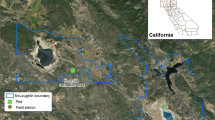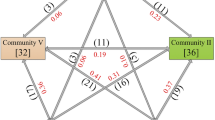Abstract
The ecological concept of Plant Functional Types (PFTs), which refers to the assemblage of plants with certain functional traits, has been introduced for the study of plant responses to the environment change and human disturbance. Taking the alpine meadow community in the Zoigê Plateau as a study case, this paper classified PFTs in terms of plant nutrition traits. The sequential results are as follows. (1) The main herbages in the Zoigê Plateau included 16 species in 5 families. Among the five families, Cyperaceae vegetation accounted for 81.37% of herbage area in total, while the remaining 4 families occupied less than 20%. As for the species, Kobresia setchwanensis Hand.-Maizz. was dominant, accounting for 48.74% of the total area; while the remaining 51.26% was comprised of Polygonum viviparum L., Anaphalis fiavescens Hand.-Mazz., Stipa aliena Keng and other species. (2) By using the Principal Component Analysis (PCA), the assessment of herbages nutrition was carried out based on the comprehensive multi-index evaluation model. Polygonum viviparum L. had the highest nutritional value score (1.43), and Stipa aliena Keng had the lowest (-1.40). Nutritional value of herbage species had a significantly positive correlation with altitude (P<0.01) in the Zoigê Plateau. (3) Based on the nutritional values, herbages in the Zoigê Plateau could be grouped into 3 nutrition PFTs (high, medium and low) by using the Natural Breaks (Jenks) method.
Similar content being viewed by others
References
Ai D, Guo CH, Xu YO, et al. (2011) Determination and analysis of fall forage nutrient contents at different altitudes and regions in Aba County, Sichuan Province. Pratacultural Science 28: 1529–1532. (In Chinese)
Bugmann H (1996) Functional types of trees in temperate and boreal forests: classification and testing. Journal of Vegetation Science 7: 359–370. https://doi.org/10.2307/3236279
Díaz S, Cabido M (1997) Plant functional types and ecosystem function in relation to global change. Journal of Vegetation Science 8: 463–474. https://doi.org/10.2307/3237198
Dong QM, Zhao XQ, Ma YS (2007) Effects of grazing intensity and time on forage nutrition contents in alpine mixed-sown grassland. Chinese Journal of Grassland 29(4): 67–73. (In Chinese)
Editorial Board of Vegetation Map of China, Chinese Academy of Sciences (2001) Vegetation Atlas of China. Science Press, Beijing, China. (In Chinese)
Fu JJ, Yixicuomu, Chen H, et al. (2013) Responses of dominant plant nutrients to grazing intensity in Kobresia pygmaea meadow of the Qinghai-Tibet plateau. Pratacultural science 30: 560–565. (In Chinese)
Gao YH, Chen H, Luo P, et al. (2008) Effect of grazing intensity on biomass of alpine meadow and its allocation in the Northwestern Sichuan. Journal of Ecology and Rural environment 24:26–32. (In Chinese) https://doi.org/10.3969/j.issn.1673-4831.2008.03.006
Goldstein MC, Beall CM (1991) Change and continuity in nomadic pastoralism on the western Tibetan Plateau. Nomadic Peoples 28:105–122.
Grabherr G, Gottfried M, Pauli H (1994) Climate effects on mountain plants. Nature 369: 448–450. https://doi.org/10.1038/369448a0
Guo YL, Wang Q, Yan WP, et al. (2015) Assessment of habitat suitability in the upper reaches of the Min River in China. Journal of Mountain Science 12: 737–746. https://doi.org/10.1007/s11629-013-2662-0
Han F, Ben GY, Shi SB, et al. (1997) Contents of protein, fat and starch of Kobresia Humilis plants grown at different altitudes in Qinghai-Xizang Plateau. Acta Phytoecologica Sinica 21(2): 97–104. (In Chinese)
Harrison SP, Prentice IC, Barboni D, et al. (2010) Ecophysiological and bioclimatic foundations for a global plant functional classification. Journal of Vegetation Science 21(2): 300–317. https://doi.org/10.1111/j.1654-1103.2009.01144.x
Heitshcmidt RK, Dowhower SL, Pinchak WE, et al. (1989) Effects of stocking rate on quantity and quality of available forage in a southern mixed grass prairie. Journal of Range Management 42(6): 468–473.
Hou FJ, Yang ZY (2006) Effects of grazing of livestock on grassland. Acta Ecologica Sinica 26: 244–264. (In Chinese)
Huntly N (1991) Herbivores and the dynamics of communities and ecosystems. Annual Review of Ecology and Systematics 22: 477–503.
Laliberte E, Wells JA, DeClerck F, et al. (2010) Land-use intensification reduces functional redundancy and response diversity in plant communities. Ecology Letters 13: 76–86. https://doi.org/10.1111/j.1461-0248.2009.01403.x
Lavorel S, Garnier E (2002) Predicting changes in community composition and ecosystem functioning from plant traits: revisiting the Holy Grail. Functional Ecology 16: 545–556. https://doi.org/10.1046/j.1365-2435.2002.00664.x
Li AN, Wang AS, He XR, et al. (2006). Integrated evaluation model for eco-environmental quality in mountainous region based on remote sensing and GIS. Wuhan University Journal of Natural Sciences 11: 969–976. (In Chinese) https://doi.org/10.1007/BF02830196
Li B, Dong SC, Jiang XB, et al. (2008) Analysis on the driving factors of grassland Desertification in Zoige wetland. Research of Soil and Water Conservation 15: 112–115,120. (In Chinese)
Li JC, Wang WL, Hu GY, et al. (2010) Changes in ecosystem service values in Zoige Plateau, China. Agriculture, Ecosystems and Environment 139: 766–770. https://doi.org/10.1016/j.agee.2010.10.019
Li Z, Zhao DY, Li RN et al. (2001) A study on dynamics of forage nutrition on seasonal grassland in the northern slope of Tianshan Mountain, Xinjiang, China. Pratacultural Science 18: 1–4. (In Chinese) https://doi.org/10.3969/j.issn.1001-0629.2001.05.001
Li W, Ciais P, Macbean N, et al. (2016) Major forest changes and land cover transitions based on plant functional types derived from the ESA CCI Land Cover product. International Journal of Applied Earth Observation and Geoinformation 47: 30–39. https://doi.org/10.1016/j.jag.2015.12.006
Liu DL, Zhao D, Zhou Y, et al. (2008) Digestible characteristics of different forages in rumen of dairy cattle. Pratacultural Science 25: 128–131. (In Chinese)
Liu ZM, Yang JD, Liu XM (2000) Effects of several environmental factors on plant physiology in Qinghai-Xizang Plateau. Journal of Desert Research 20: 309–313. (In Chinese) https://doi.org/10.3321/j.issn:1000-694X.2000.03.020
Lu H, Cong J, Liu X, et al. (2015) Plant diversity patterns along altitudinal gradients in alpine meadows in the Three River Headwater Region, China. Acta Prataculturae Sinica 24:197–204. (In Chinese) https://doi.org/10.11686/cyxb2014347
Mintzer IM (1992) Confronting Climate Change: Risks, Implications and Responses. Cambridge University Press, Cambridge.
Negreiros D, Le SS, Fernandes GW, et al. (2014) CSR analysis of plant functional types in highly diverse tropical grasslands of harsh environments. Plant Ecology 215: 379–388. https://doi.org/10.1007/s11258-014-0302-6
Pettorelli N, Vik JO, Mysterud A, et al. (2005) Using the satellite-derived NDVI to assess ecological responses to environmental change. Trends in Ecology & Evolution 20(9): 503–510. https://doi.org/10.1016/j.tree.2005.05.011
Silva IA, Batalha MA (2011) Plant functional types in Brazilian savannas: The niche partitioning between herbaceous and woody species. Perspectives in Plant Ecology, Evolution and Systematics 13: 201–206. https://doi.org/10.1016/j.ppees.2011.05.006
Skarpe C (2009) Plant Functional Types and Climate in a Southern African Savanna. Journal of Vegetation Science 7: 397–404. https://doi.org/10.2307/3236283
Sun HZ, Guo QX, Zhou XF (2004) Classification attribute and approach of plant functional types. Journal of Northeast Forestry University 32: 81–83. (In Chinese)
Tang GA, Song J (2006) Comparison of slope classification methods in slope mapping from DEMs. Journal of Soil and Water Conservation 20: 157–160, 192. (In Chinese) https://doi.org/10.3321/j.issn:1009-2242.2006.02.038
Tian YB (2005) The vegetation type and its distribution regularity under different habitats in Ruoergai Plateau. Journal of Yangtze University (Natural Science Edition) 2: 1–5. (In Chinese) https://doi.org/10.3969/j.issn.1673-1409-C.2005.02.001
Wana D, Beierkuhnlein C (2011) Responses of plant functional types to environmental gradientsin the south-west Ethiopian highlands. Journal of Tropical Ecology 27: 289–304. https://doi.org/10.1017/S0266467410000799
Wang HH, Li YX, Wang JZ, et al. (2010) The evaluation of grassland resources and its nutrition in southeastern Tibet. Pratacultural Science 27: 56–59. (In Chinese)
Wang JT, Li BS (1982) Main types and characteristics of highcold steppe in the Qingtang Plateau of Xizang. Acta Phytoecologica Et Geobotanica Sinica 6: 1–13. (In Chinese)
Wang RZ (2004) Plant functional types and their ecological responses to salinization in saline grasslands, Northeastern China. Photosynthetica 42: 511–519. https://doi.org/10.1007/S11099-005-0006-1
Weng ES, Zhou GS (2005) Defining plant functional types in China for global change studies. Acta Phytoecologica Sinica 29: 81–97. (In Chinese) https://doi.org/10.17521/cjpe.2005.0012
Xia M, Gui R, Na RS (2000) Analysis and evaluation on artificial cultivating grass with hierarchical cluster. Grassland of China 4: 33–37. (In Chinese)
Xie XL, Zhou R, Xie HS, et al. (2014) The clonal phenotypic variation and reproductive strategies of Kobresia setchwanensis along altitude in Northern Tibet. Pratacultural Science 31: 2270–2276. (In Chinese) https://doi.org/10.11829/j.issn.1001-0629.2014-0059
Xin YC, Zhang LQ (2011) The nutrition types of natural grassland in Qinghai. Qinghai Prataculture 20: 27–30. (In Chinese)
Xu SX, Zhao XQ, Sun P, et al. (2002) A simulative study on effects of climate warming on nutrient contents and in vitro digestibility of herbage grown in Qinghai-Xizang Plateau. Acta Botanica Sinica 44: 1357–1364. https://doi.org/10.3321/j.issn:1672-9072.2002.11.016
Zhang SY, Lu GQ, Wu H, et al. (1992) Photosynthesis of major C3 plants on Qinghai Plateau. Acta Botanica Sinica 34(2): 176–184.
Zhang GS, Fu Y, Yang Q, et al. (2009) Characteristic of spatial distribution and climate zone of natural grassland types in Qinghai. Pratacultural Science 26: 23–31. (In Chinese)
Zhang Y (2012) Application of SPSS software and principle component analysis method in evaluation of forage nutrition value. Journal of Anhui Agricultural Sciences 40: 7186–7188. (In Chinese) https://doi.org/10.13989/j.cnki.0517-6611.2012.12.227
Zhang YP, Jiang Y, Liu QR, et al. (2011) Impacts of grazing on herbage quality of the alpine and subalpine meadows within Wutai Mountain. Acta Ecologica Sinica 31: 3659–3667.(In Chinese)
Zhao HL, Zhang TH, Chang XL, et al. (1999) Cluster analysis on change laws of the vegetation under different grazing densities in Horqin sandy pasture. Journal of Desert Research 19: 40–44. (In Chinese)
Acknowledgements
The authors express our respect and gratitude to the anonymous reviewers and the handling editor for their valuable comments, which improved the quality of the paper. Our research was supported by the sub topics of National Key Technology R&D Program (Grant No. 2015BAC05B05-01).
Author information
Authors and Affiliations
Corresponding author
Rights and permissions
About this article
Cite this article
Shen, St., Zhang, Sj., Fan, M. et al. Classification of plant functional types based on the nutrition traits: a case study on alpine meadow community in the Zoigê Plateau. J. Mt. Sci. 14, 2003–2012 (2017). https://doi.org/10.1007/s11629-016-4133-x
Received:
Revised:
Accepted:
Published:
Issue Date:
DOI: https://doi.org/10.1007/s11629-016-4133-x




